Spatiotemporal Analysis of Forest Fires in China from 2012 to 2021 Based on Visible Infrared Imaging Radiometer Suite (VIIRS) Active Fires
Abstract
:1. Introduction
2. Materials and Methods
2.1. Study Area
2.2. Study Data
2.2.1. VIIRS Active Fire Data
2.2.2. Land Cover Data
2.3. Data Processing Methods
2.3.1. Method of Spatiotemporal Clustering
2.3.2. Method of Spread Reconstruction
2.3.3. Method of Mathematical Statistics
3. Results and Discussion
3.1. Pearson Analysis
- The correlation coefficient between FFS and FFE is 0.957, indicating an extremely strong relationship between the two. This means that FFE can be accurately estimated from FFS, especially in situations in which obtaining direct measurements of FFE may be difficult. Overall, these findings highlight the importance of the relationship between FFS and FFE for effective forest fire management and prevention.
- FFS and FFE have an extremely strong correlation. This indicates that, despite the condition filtering of 10 clustering spots during temporal and spatial clustering, the forest fire events obtained can still comprehensively reflect the occurrence of forest fires, not just in terms of space or time.
- The correlation analysis shows that LFFE had strong correlations of 0.666 and 0.772 with FFS and FFE, respectively. These results suggest that by monitoring FFS and FFE, it may be possible to predict the likelihood of large forest fires occurring. This information could be very valuable in preventing and controlling large fires.
- The correlation coefficients between the average burned area and FFS and FFE are 0.298 and 0.347, respectively, which are weak correlations. This suggests that burned areas may have different characteristics for forest fires compared to fire frequency, and therefore a comprehensive study of this metric is necessary. The burned area can provide more insights into the severity and intensity of forest fires.
- The correlation coefficient between LFFE and the average burned area is 0.412, indicating a moderate positive relationship. This means that as LFFE increase, the average burned area also tends to increase, but the relationship is not very strong. It is crucial to take into consideration other factors that could affect the area burned by a forest fire, such as topography, climate, vegetation type, and human activity.
- Overall, the correlations among the different metrics highlight their validity and value in analyzing forest fires from various perspectives. By considering multiple indicators, we can gain comprehensive insights that help to improve our understanding of forest fire dynamics, enhance our ability to mitigate and prevent such events, and assist in the development of more effective strategies for their management.
3.2. Spatial Characteristics
3.2.1. Five Regional Scales
3.2.2. Provincial Scale
3.3. Spatiotemporal Characteristics
3.3.1. Annual Analyses
3.3.2. Monthly Analyses
3.3.3. Duration Analyses
3.3.4. Spread Rate Analyses
4. Conclusions
Author Contributions
Funding
Institutional Review Board Statement
Informed Consent Statement
Data Availability Statement
Acknowledgments
Conflicts of Interest
References
- Giglio, L.; Randerson, J.T.; van der Werf, G.R. Analysis of daily, monthly, and annual burned area using the fourth-generation global fire emissions database (GFED4). J. Geophys. Res. Biogeosci. 2013, 118, 317–328. [Google Scholar] [CrossRef] [Green Version]
- Alkhatib, A.A. A review on forest fire detection techniques. Int. J. Distrib. Sens. Netw 2014, 10, 597368. [Google Scholar] [CrossRef] [Green Version]
- Van Der Werf, G.R.; Randerson, J.T.; Giglio, L.; Collatz, G.J.; Mu, M.; Kasibhatla, P.S.; Morton, D.C.; Defries, R.S.; Jin, Y.; Van Leeuwen, T.T. Global fire emissions and the contribution of deforestation, savanna, forest, agricultural, and peat fires (1997–2009). Atmos. Chem. Phys. 2010, 10, 11707–11735. [Google Scholar] [CrossRef] [Green Version]
- Cardil, A.; Molina-Terren, D. Factors Causing Victims of Wildland Fires in Spain (1980–2010). Hum. Ecol. Risk Assess. Int. J. 2015, 21, 67–80. [Google Scholar] [CrossRef]
- Diakakis, M.; Xanthopoulos, G.; Gregos, L. Analysis of forest fire fatalities in Greece: 1977–2013. Int. J. Wildland Fire 2016, 25, 797–809. [Google Scholar] [CrossRef]
- Balch, J.K.; Bradley, B.A.; Abatzoglou, J.T.; Nagy, R.C.; Fusco, E.J.; Mahood, A.L. Mahood Adam L. Human-started wildfires expand the fire niche across the United States. Proc. Natl. Acad. Sci. USA 2017, 114, 2946–2951. [Google Scholar] [CrossRef] [PubMed] [Green Version]
- Pechony, O.; Shindell, D.T. Driving forces of global wildfires over the past millennium and the forthcoming century. Proc. Natl. Acad. Sci. USA 2010, 107, 19167–19170. [Google Scholar] [CrossRef] [Green Version]
- Cardil, A.; Eastaugh, C.S.; Molina-Terren, D. Extreme temperature conditions and wildland fires in Spain. Theor. Appl. Climatol. 2015, 122, 219–228. [Google Scholar] [CrossRef]
- Taylor, A.H.; Trouet, V.; Skinner, C.N.; Stephens, S. Socioecological transitions trigger fire regime shifts and modulate fire-climate interactions in the Sierra Nevada, USA, 1600–2015 CE. Proc. Natl. Acad. Sci. USA 2016, 113, 13684–13689. [Google Scholar] [CrossRef] [PubMed] [Green Version]
- Westerling, A.L.; Hidalgo, H.G.; Cayan, D.R.; Swetnam, T.W. Warming and Earlier Spring Increase Western U.S. Forest Wildfire Activity. Science 2006, 313, 940–943. [Google Scholar] [CrossRef] [PubMed] [Green Version]
- Jolly, W.M.; Cochrane, M.A.; Freeborn, P.H.; Holden, Z.A.; Brown, T.J.; Williamson, G.J.; Bowman, D.M.J.S. Climate-induced variations in global wildfire danger from 1979 to 2013. Nat. Commun. 2015, 6, 7537. [Google Scholar] [CrossRef] [Green Version]
- Bowman, D.M.J.S.; Balch, J.K.; Artaxo, P.; Bond, W.J.; Carlson, J.M.; Cochrane, M.A.; D’Antonio, C.M.; DeFries, R.S.; Doyle, J.C.; Harrison, S.P.; et al. Fire in the Earth System. Science 2009, 324, 481–484. [Google Scholar] [CrossRef] [PubMed]
- Archibald, S.; Staver, A.C.; Levin, S.A. Evolution of human-driven fire regimes in Africa. Proc. Natl. Acad. Sci. USA 2012, 109, 847–852. [Google Scholar] [CrossRef] [PubMed] [Green Version]
- Keeley, J.E.; Syphard, A.D. Climate Change and Future Fire Regimes: Examples from California. Geosciences 2016, 6, 37. [Google Scholar] [CrossRef] [Green Version]
- Wei, X.; Wang, G.; Chen, T.; Hagan, D.F.T.; Ullah, W. A Spatio-Temporal Analysis of Active Fires over China during 2003–2016. Remote Sens. 2020, 12, 1787. [Google Scholar] [CrossRef]
- Andela, N.; Morton, D.C.; Giglio, L.; Paugam, R.; Chen, Y.; Hantson, S.; van der Werf, G.R.; Randerson, J.T. The Global Fire Atlas of individual fire size, duration, speed and direction. Earth Syst. Sci. Data 2019, 11, 529–552. [Google Scholar] [CrossRef] [Green Version]
- Schroeder, W.; Oliva, P.; Giglio, L.; Quayle, B.; Lorenz, E.; Morelli, F. Active fire detection using Landsat–8/OLI data. Remote Sens. Environ 2016, 185, 210–220. [Google Scholar] [CrossRef] [Green Version]
- Li, P.; Xiao, C.; Feng, Z.; Li, W.; Zhang, X. Occurrence frequencies and regional variations in Visible Infrared Imaging Radiometer Suite (VIIRS) global active fires. Glob. Chang. Biol. 2020, 26, 2970–2987. [Google Scholar] [CrossRef]
- Giglio, L.; Csiszar, I.; Justice, C.O. Global distribution and seasonality of active fires as observed with the Terra and Aqua Moderate Resolution Imaging Spectroradiometer (MODIS) sensors. J. Geophys. Res. Biogeosci. 2006, 111, G02016. [Google Scholar] [CrossRef]
- Hantson, S.; Padilla, M.; Corti, D.; Chuvieco, E. Strengths and weaknesses of MODIS hotspots to characterize global fire occurrence. Remote Sens. Environ. 2013, 131, 152–159. [Google Scholar] [CrossRef]
- van der Werf, G.R.; Randerson, J.T.; Giglio, L.; van Leeuwen, T.T.; Chen, Y.; Rogers, B.M.; Mu, M.; van Marle, M.J.E.; Morton, D.C.; Collatz, G.J.; et al. Global fire emissions estimates during 1997–2016. Earth Syst. Sci. Data 2017, 9, 697–720. [Google Scholar] [CrossRef] [Green Version]
- Thorsteinsson, T.; Magnusson, B.; Gudjonsson, G. Large wildfire in Iceland in 2006: Size and intensity estimates from satellite data. Int. J. Remote Sens. 2011, 32, 17–29. [Google Scholar] [CrossRef]
- Yaduvanshi, A.; Srivastava, P.K.; Pandey, A. Integrating TRMM and MODIS satellite with socio-economic vulnerability for monitoring drought risk over a tropical region of India. Phys. Chem. Earth 2015, 83–84, 14–27. [Google Scholar] [CrossRef]
- Giglio, L.; Descloitres, J.; Justice, C.O.; Kaufman, Y.J. An Enhanced Contextual Fire Detection Algorithm for MODIS. Remote Sens. Environ. 2003, 87, 273–282. [Google Scholar] [CrossRef]
- Schroeder, W.; Oliva, P.; Giglio, L.; Csiszar, I.A. The New VIIRS 375m active fire detection data product: Algorithm description and initial assessment. Remote Sens. Environ. 2014, 143, 85–96. [Google Scholar] [CrossRef]
- Aragão, L.E.O.C.; Anderson, L.O.; Fonseca, M.G.; Rosan, T.M.; Vedovato, L.B.; Wagner, F.H.; Silva, C.V.J.; Silva Junior, C.H.L.; Arai, E.; Aguiar, A.P.; et al. 21st Century drought-related fires counteract the decline of Amazon deforestation carbon emissions. Nat. Commun. 2018, 9, 536. [Google Scholar] [CrossRef] [Green Version]
- Van Leeuwen, T.T.; van der Werf, G.R.; Hoffmann, A.A.; Detmers, R.G.; Rücker, G.; French, N.H.F.; Archibald, S.; Carvalho, J.A., Jr.; Cook, G.D.; de Groot, W.J.; et al. Biomass burning fuel consumption rates: A field measurement database. Biogeosciences 2014, 11, 7305–7329. [Google Scholar] [CrossRef] [Green Version]
- Lian, C.; Xiao, C.; Feng, Z. Spatiotemporal Characteristics and Regional Variations of Active Fires in China since 2001. Remote Sens. 2022, 15, 54. [Google Scholar] [CrossRef]
- Zhuang, Y.; Li, R.; Yang, H.; Chen, D.; Chen, Z.; Gao, B.; He, B. Understanding Temporal and Spatial Distribution of Crop Residue Burning in China from 2003 to 2017 Using MODIS Data. Remote Sens. 2018, 10, 390. [Google Scholar] [CrossRef] [Green Version]
- Ke, H.; Gong, S.; He, J.; Zhou, C.; Zhang, L.; Zhou, Y. Spatial and temporal distribution of open bio-mass burning in China from 2013 to 2017. Atmos. Environ. 2019, 210, 156–165. [Google Scholar] [CrossRef]
- Müller, D.; Suess, S.; Hoffmann, A.A.; Buchholz, G. The value of satellite–based active fire data for monitoring, reporting and verification of REDD+ in the Lao PDR. Hum. Ecol. 2013, 41, 7–20. [Google Scholar] [CrossRef]
- Xie, H.; Du, L.; Liu, S.; Chen, L.; Gao, S.; Liu, S.; Pan, H.; Tong, X. Dynamic Monitoring of Agricultural Fires in China from 2010 to 2014 Using MODIS and GlobeLand30 Data. ISPRS Int. J. Geo-Inf. 2016, 5, 172. [Google Scholar] [CrossRef] [Green Version]
- Tian, X.; Zhao, F.; Shu, L.; Wang, M. Distribution characteristics and the influence factors of forest fires in China. For. Ecol. Manag. 2013, 310, 460–467. [Google Scholar] [CrossRef]
- Tian, Y.; Wu, Z.; Bian, S.; Zhang, X.; Wang, B.; Li, M. Study on Spatial-Distribution Characteristics Based on Fire-Spot Data in Northern China. Sustainability 2022, 14, 6872. [Google Scholar] [CrossRef]
- Li, W.; Li, P.; Feng, Z. Delineating Fire-Hazardous Areas and Fire-Induced Patterns Based on Visible Infrared Imaging Radiometer Suite (VIIRS) Active Fires in Northeast China. Remote Sens. 2022, 14, 5115. [Google Scholar] [CrossRef]
- Veraverbeke, S.; Sedano, F.; Hook, S.J.; Randerson, J.T.; Jin, Y.; Rogers, B.M. Mapping the daily progression of large wildland fires using MODIS active fire data. Int. J. Wildland Fire 2014, 23, 655–667. [Google Scholar] [CrossRef] [Green Version]
- Loboda, T.; Csiszar, I. Reconstruction of fire spread within wildland fire events in Northern Eurasia from the MODIS active fire product. Glob. Planet. Chang. 2006, 56, 258–273. [Google Scholar] [CrossRef]
- Cardíl, A.; Tapia, V.M.; Monedero, S.; Quiñones, T.; Little, K.; Stoof, C.R.; Ramirez, J.; De-Miguel, S. Characterizing the rate of spread of large wildfires in emerging fire environments of northwestern Europe using Visible Infrared Imaging Radiometer Suite active fire data. Nat. Hazards Earth Syst. Sci. 2023, 23, 361–373. [Google Scholar] [CrossRef]
- Yuan, Q.; Wang, G.; Zhu, C.; Lou, D.; Hagan, D.F.T.; Ma, X.; Zhan, M. Coupling of soil moisture and air temperature from multiyear data during 1980–2013 over china. Atmosphere 2020, 11, 25. [Google Scholar] [CrossRef] [Green Version]
- Mao, F.; Cheng, G.; Jin, H. Pergélisol et eau de nappe sur le Plateau Qinghai-Tibet et dans le Nord-Est de la Chine. Hydrogeol. J. 2013, 21, 5–23. [Google Scholar] [CrossRef]
- Li, S.; Jiang, Z.; Zhang, W.; Yu, M. Spatial and temporal variations in precipitation and their influencing factors in China from 1961 to 2010. Int. J. Climatol. 2017, 37, 345–358. [Google Scholar] [CrossRef]
- Huang, Y.; Li, L.; Xu, C.; Cheng, J.; Xu, X.; Zheng, T.; Zhang, X. Spatiotemporal distribution patterns of deadly geohazard events in China, 2013–2019. Nat. Hazards Res. 2022, 2, 316–324. [Google Scholar] [CrossRef]
- Xu, X.; Liu, J.; Zhang, S.; Li, W.; Yan, C.; Wu, S. China’s Multi-Period Land Use Land cover Remote sensing Monitoring Dataset (CNLUCC)[EB/OL]. Data Registration and Publishing System of the Resource and Environmental Science Data Center of the Chinese Academy of Sciences 2018. Available online: https://www.resdc.cn/DOI/doi.aspx?DOIid=54 (accessed on 4 January 2023).
- Chen, J.; Li, R.; Tao, M.; Wang, L.; Lin, C.; Wang, J.; Wang, L.; Wang, Y.; Chen, L. Overview of the performance of satellite fire products in China: Uncertainties and challenges. Atmos. Environ. 2022, 268, 118838. [Google Scholar] [CrossRef]
- Chuvieco, E.; Giglio, L.; Justice, C. Global characterization of fire activity: Toward defining fire regimes from Earth observation data. Glob. Chang. Biol. 2008, 14, 1488–1502. [Google Scholar] [CrossRef]
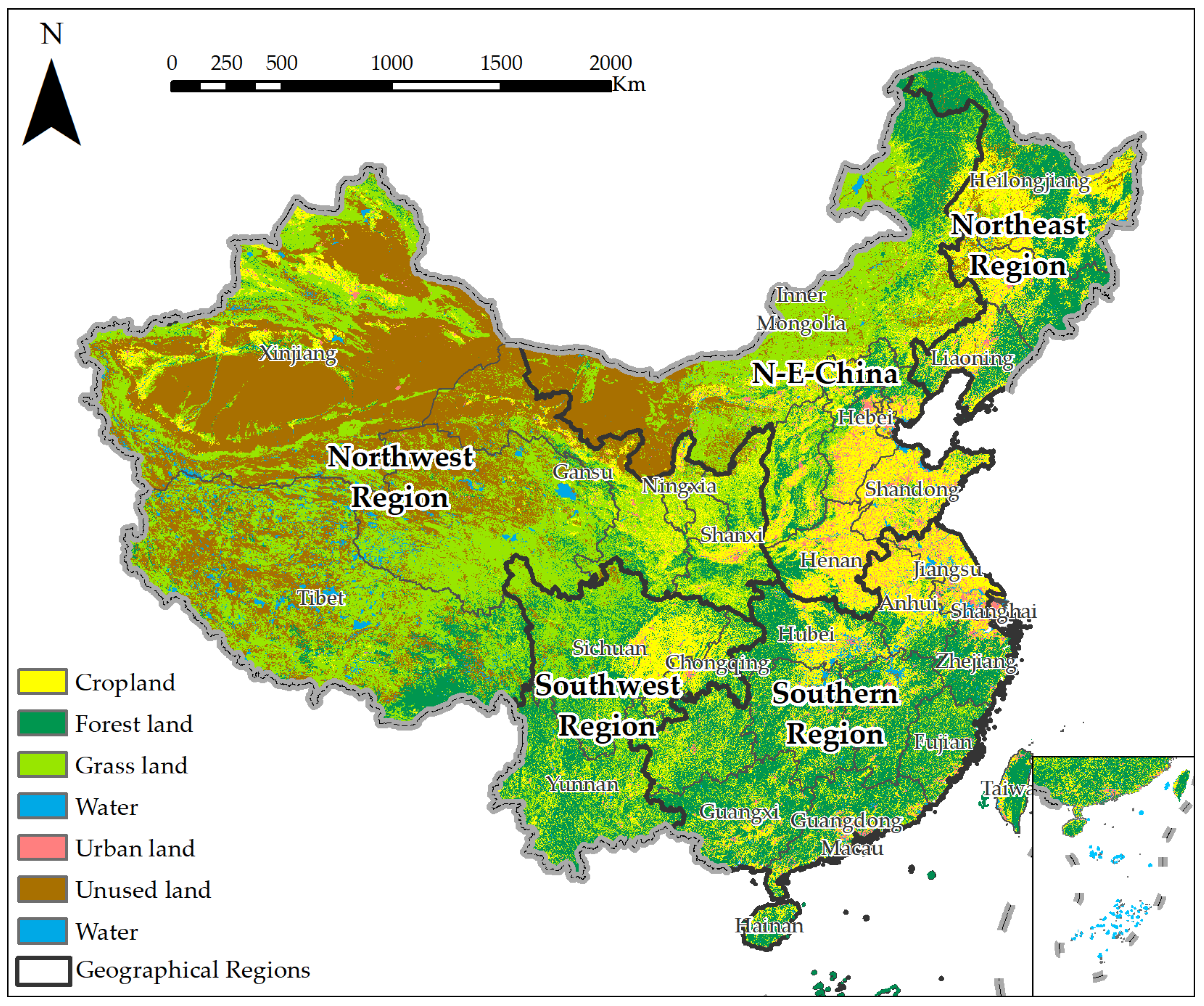
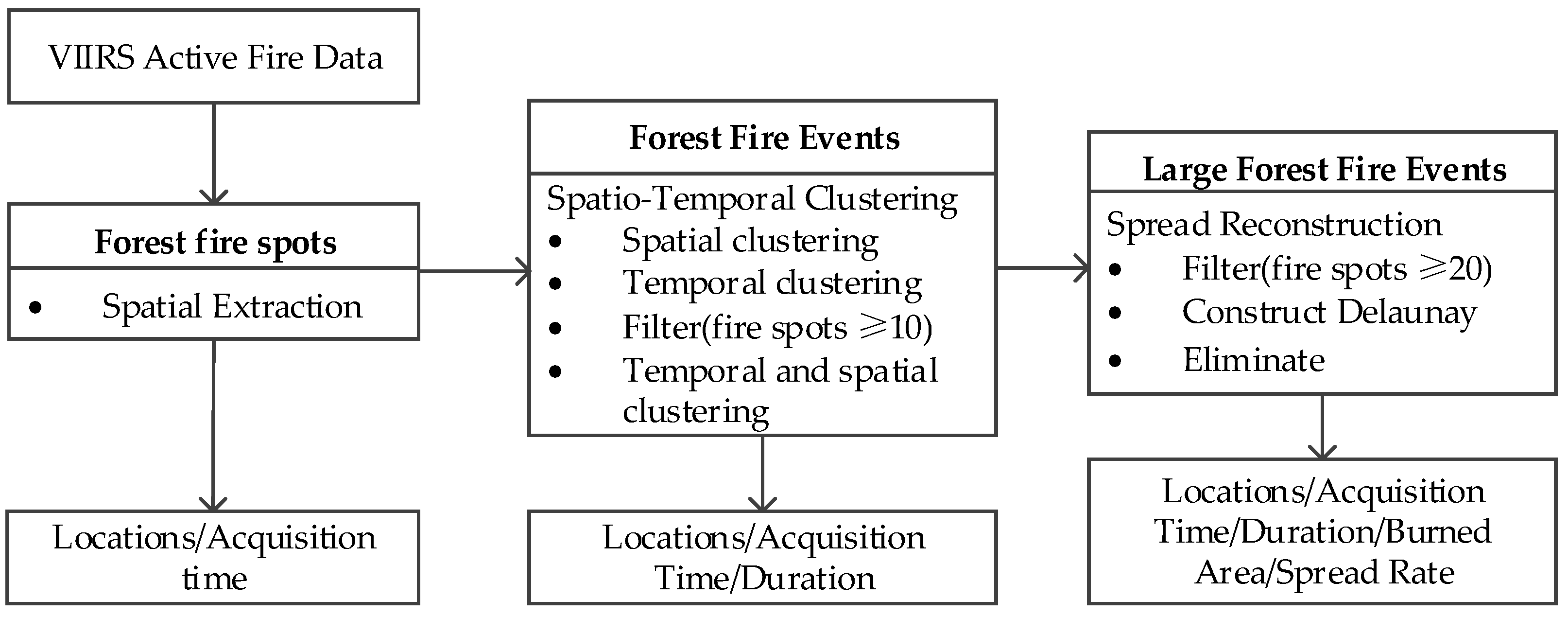

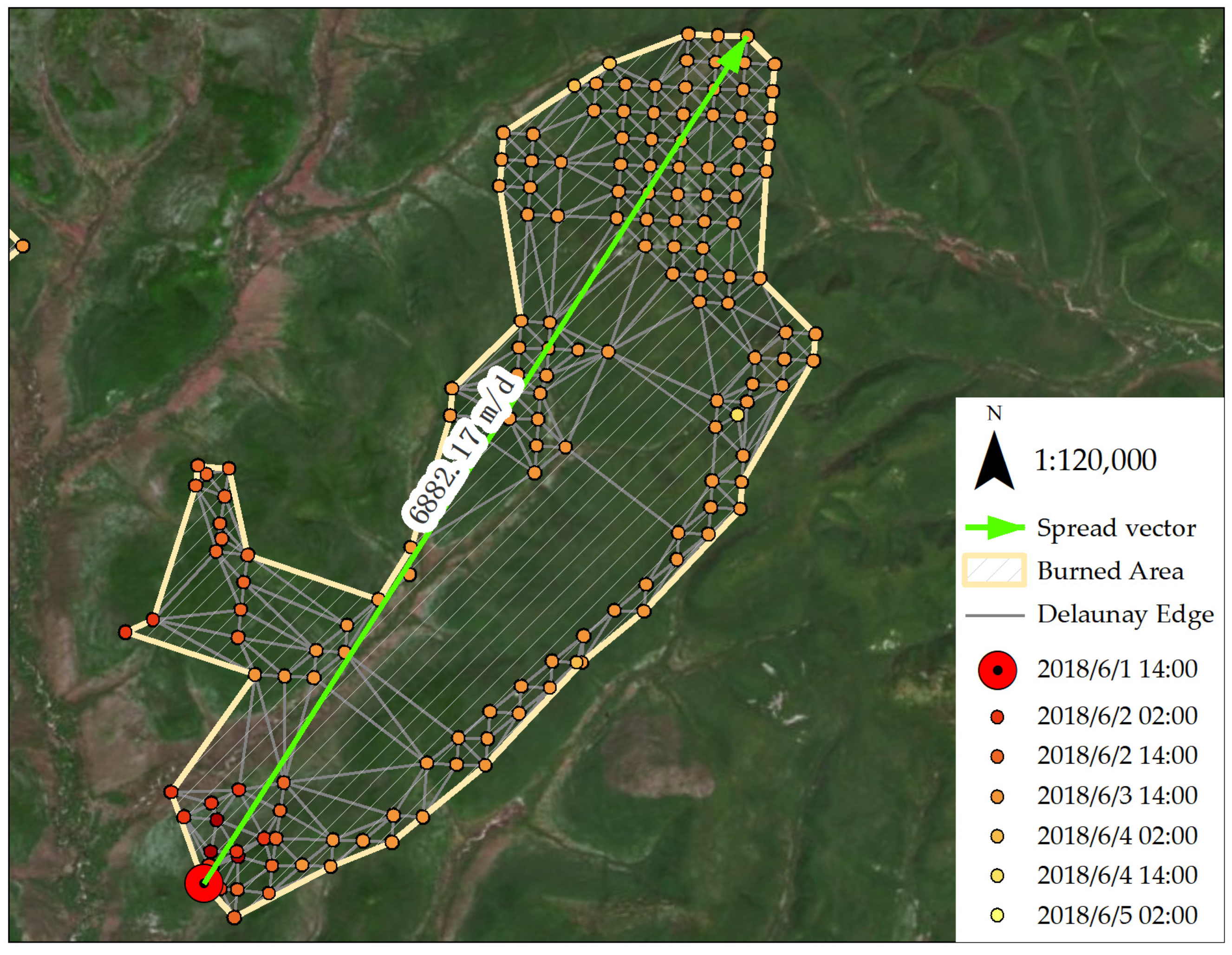
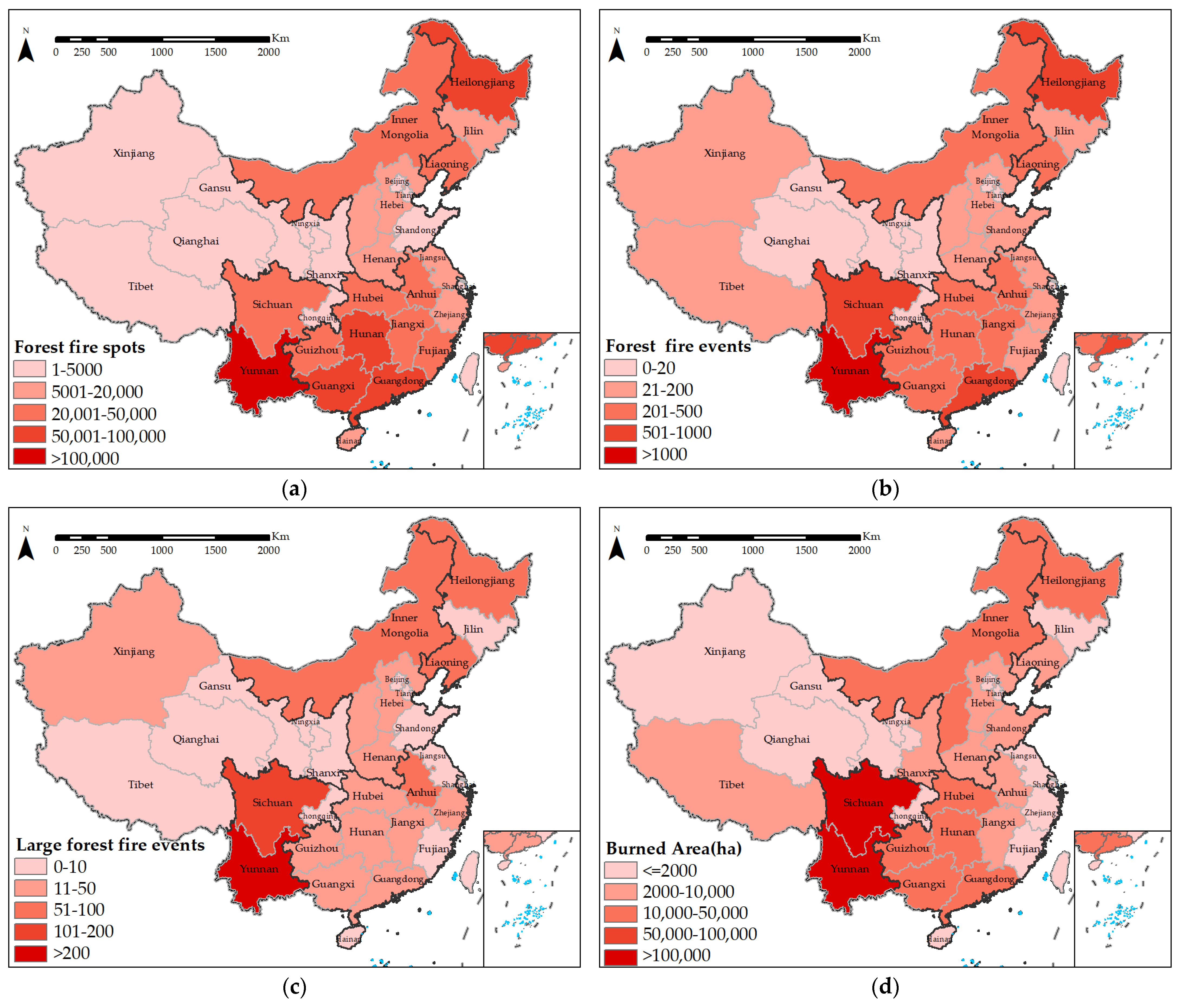
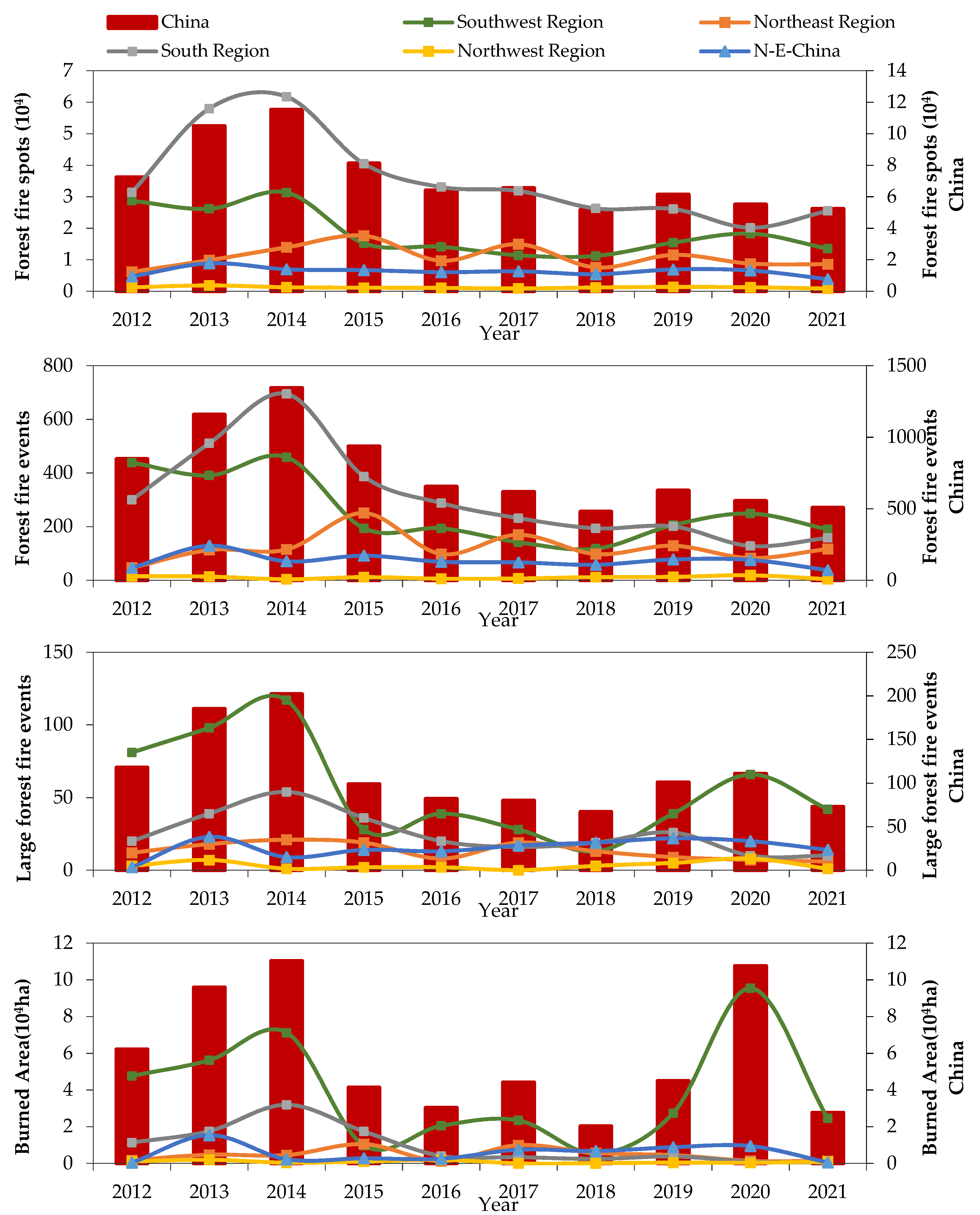

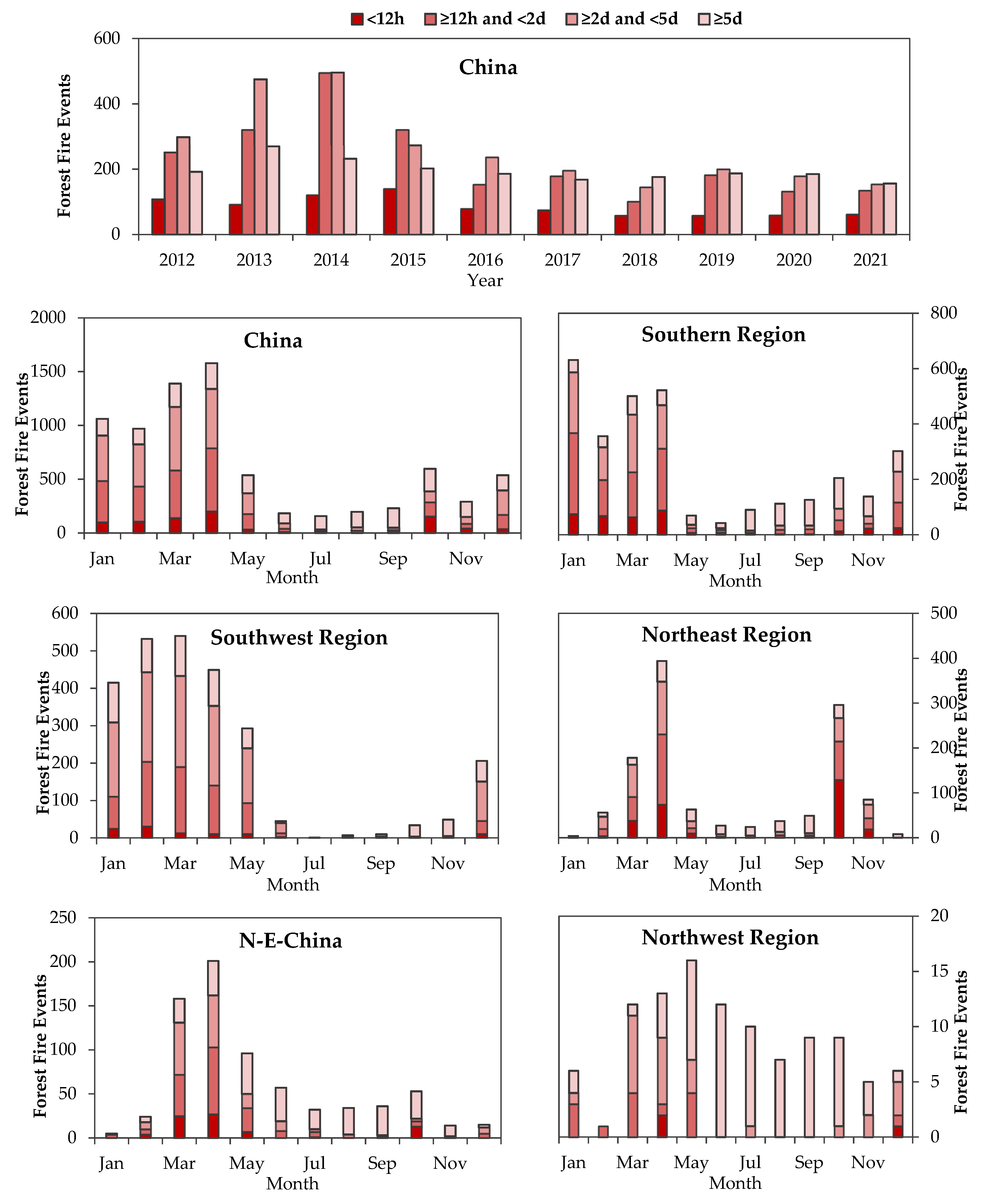
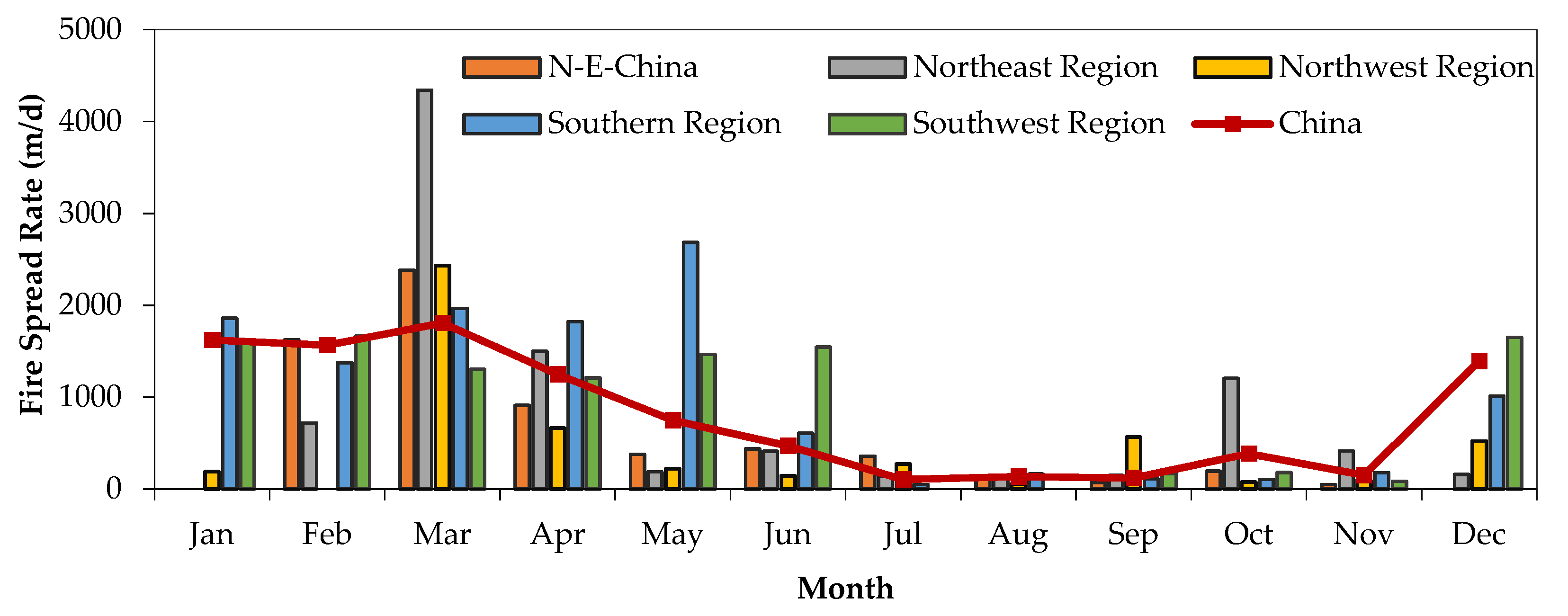
| Metrics | FFS | FFE | LFFE | Average Burned Area |
|---|---|---|---|---|
| FFS | 1 | 0.957 | 0.666 | 0.298 |
| FFE | 0.957 | 1 | 0.772 | 0.347 |
| LFFE | 0.666 | 0.772 | 1 | 0.412 |
| Average burned area | 0.298 | 0.347 | 0.412 | 1 |
| Regions | Forest Area (106 ha) | Forest Cover (%) | FFS (104) | FFE | LFFE | Burned Area (104 ha) |
|---|---|---|---|---|---|---|
| Southern Region | 81.19 | 49.10 | 35.5 | 3094 | 249 | 9.3 |
| Southwest Region | 43.00 | 45.30 | 18.6 | 2582 | 552 | 38.1 |
| Northeast Region | 33.47 | 42.40 | 10.9 | 1221 | 132 | 4.5 |
| N-E-China | 42.02 | 22.30 | 6.3 | 725 | 153 | 5.6 |
| Northwest Region | 41.75 | 9.70 | 1.2 | 106 | 32 | 0.81 |
| China | 220.45 | 22.96 | 72.41 | 7728 | 1118 | 58.4 |
Disclaimer/Publisher’s Note: The statements, opinions and data contained in all publications are solely those of the individual author(s) and contributor(s) and not of MDPI and/or the editor(s). MDPI and/or the editor(s) disclaim responsibility for any injury to people or property resulting from any ideas, methods, instructions or products referred to in the content. |
© 2023 by the authors. Licensee MDPI, Basel, Switzerland. This article is an open access article distributed under the terms and conditions of the Creative Commons Attribution (CC BY) license (https://creativecommons.org/licenses/by/4.0/).
Share and Cite
Dong, B.; Li, H.; Xu, J.; Han, C.; Zhao, S. Spatiotemporal Analysis of Forest Fires in China from 2012 to 2021 Based on Visible Infrared Imaging Radiometer Suite (VIIRS) Active Fires. Sustainability 2023, 15, 9532. https://doi.org/10.3390/su15129532
Dong B, Li H, Xu J, Han C, Zhao S. Spatiotemporal Analysis of Forest Fires in China from 2012 to 2021 Based on Visible Infrared Imaging Radiometer Suite (VIIRS) Active Fires. Sustainability. 2023; 15(12):9532. https://doi.org/10.3390/su15129532
Chicago/Turabian StyleDong, Bing, Hongwei Li, Jian Xu, Chaolin Han, and Shan Zhao. 2023. "Spatiotemporal Analysis of Forest Fires in China from 2012 to 2021 Based on Visible Infrared Imaging Radiometer Suite (VIIRS) Active Fires" Sustainability 15, no. 12: 9532. https://doi.org/10.3390/su15129532
APA StyleDong, B., Li, H., Xu, J., Han, C., & Zhao, S. (2023). Spatiotemporal Analysis of Forest Fires in China from 2012 to 2021 Based on Visible Infrared Imaging Radiometer Suite (VIIRS) Active Fires. Sustainability, 15(12), 9532. https://doi.org/10.3390/su15129532





